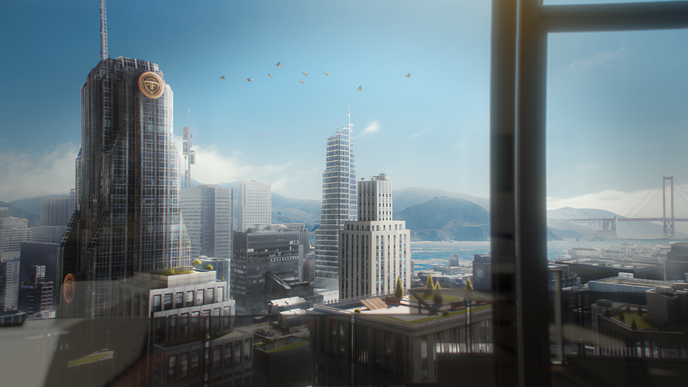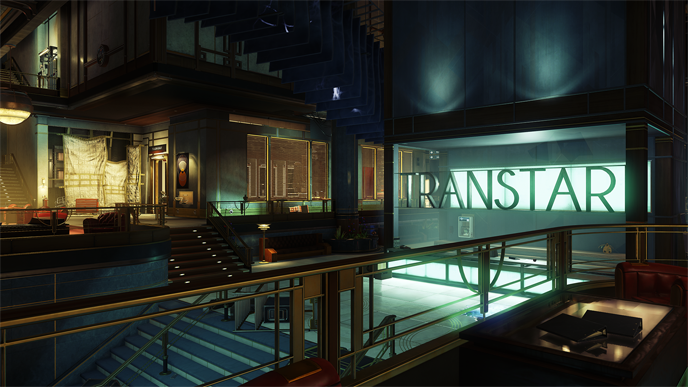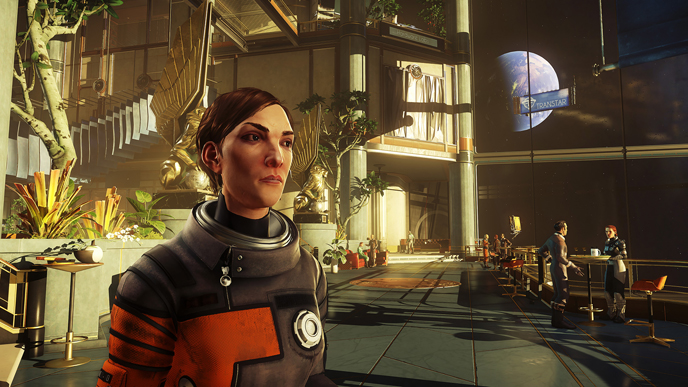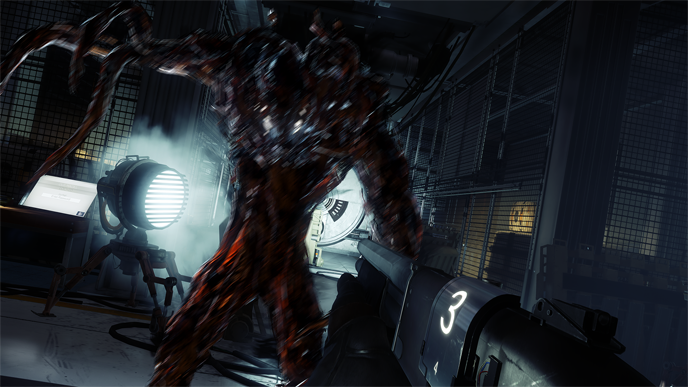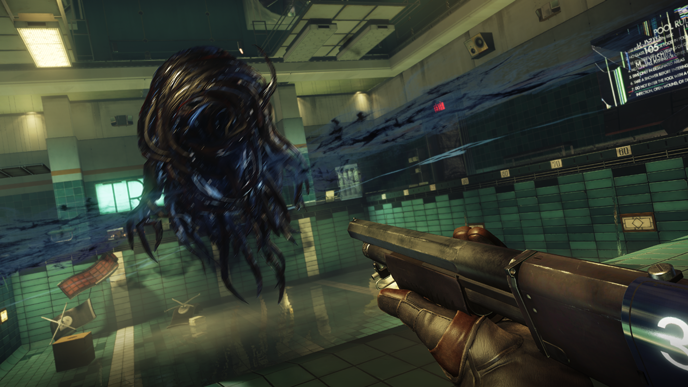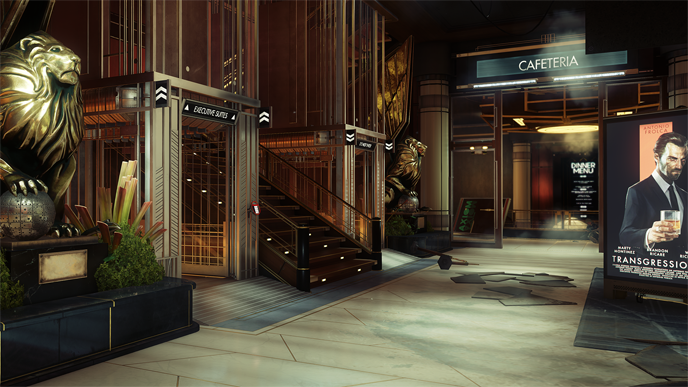Dizzying, Disorienting, and Enticing: This is Not The Prey We Once Knew
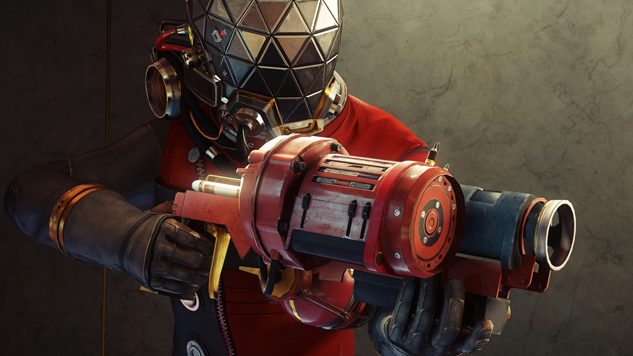
Prey is disorienting from the start. The demo begins with me (as the androgynously-named protagonist Morgan Yu) waking up in a high-rise studio apartment, furnished and decorated with contemporary flavor. I’m greeted with a call from Alex Yu, Morgan’s scientist brother working at the omnipresent TranStar Corporation. Voicing his happiness in my choice to work with him, he invites me down to the lab to begin some nondescript “testing.”
After a strong opening with in-world credits and a thumping EDM track, Morgan is escorted into the TranStar Labs, meeting behind glass with a group of researchers and asked to do several menial tasks while they cryptically discuss disappointing results in hushed tones.
The lead researcher asks for coffee from an assistant, then shortly after picks up the mug to find it’s empty. He begins to complain when the mug morphs into a twisted, inky black figure and violently impales him through the throat. As the lab outside falls into chaos, green gas fills the room and the world goes dark.
Again, Morgan awakens in the apartment. The sun is out, and all of the items that were scattered around the room previously remain in their place, seemingly untouched. For a brief moment it feels like a Groundhog Day-style story, where the same day is repeated again and again.
That suspicion is killed when I check Morgan’s email and find a litany of messages, all from an unknown source issuing a warning to escape the building immediately. Donning my testing suit and walking into the hall, I’m greeted by the twisted, garish corpse of a maintenance worker outside my doorway. This time, there is no exit; no elevator like there was before. There is only a wrench, glistening on the ground beside the corpse.
I pick it up, observing it with a hint of reverence and instantly experiencing a touch of Déjà vu from the earliest moments of the likes of BioShock and System Shock. The familiarity, according to Creative Director Raphael Colantonio, is was entirely on purpose.
“Dishonored was very inspired by Thief, and this time we wanted to make a System Shock-like enclosed experience,” he says, referencing the closer-knit environment in which Prey takes place.
The influence of System Shock is indeed felt; the bulk of the demo takes place in an industrialized research facility overrun with horrors, the player uses future tech is used as a means to deliver upgrades and items, and the entire game is set on a station floating through space.
Still, Prey does enough on its own to feel influenced by instead of outright copying System Shock. It has a unique universe made up of diverse characters and intrigue, and its combat is built similarly to that of Dishonored, offering both natural and supernatural abilities as the game progresses. Its setting also feels a little more grounded, reminiscent of something found in the likes of the films Moon and Europa Report.
Making Sense of the Intrigue
Lights flicker in the hallway as I return to the apartment. Searching for an alternate exit, I approach the sliding glass window leading to the balcony. It’s locked. I glance at the wrench and tap the right trigger, reaching back and bringing the heavy tool smashing down on the glass surface.
Time slows, a bass drop rattles within my headphones, and beyond the glass the bright morning sunlight is replaced with a dark, unrecognizable environment. After taking a moment to study it, I realize the unfamiliar environment is a sound stage peeking through my bizarre façade. I jump through, leaving behind a perfectly-constructed set and emerging into the abandoned room.
This scene alone is one Colantonio and his team meticulously crafted during development, due to their belief that its success is essential to help communicate the bizarre nature of the situation in which Morgan has been dropped.
“There was a lot of effort put on that specific scene, when you escape [the apartment] and realize that all of the geometry [surrounding you] was actually a dud,” he says. Each moment in Prey’s opening scenes are deliberately crafted. Every aspect—from interior design to the characters present—has been carefully implemented to build a twisted, believable, and disorienting world.
Celebrating Diversity
One of its most important traits is seen immediately after starting the game. The title screen fades, and players are given an option of playing as either a man or a woman. A seemingly insignificant option, this choice was included by the developers at Arkane Studios in an effort to help players feel reflected within the game.
It’s one of the many steps the team has taken to create an experience reflective of the world and the diverse population of its players.
“[Prey] is a game where we want the player to identify [with] as much as possible,” Colantonio explains.
He goes on to say that it was necessary to make Morgan come across as a semi-blank slate, an avatar on which players could project aspects of themselves. This is why Morgan is not voiced from the player’s perspective.
“There’s really no ‘main’ character; the player is the character,” he says. “We wanted to give you all the possibilities to be as close to the player character as possible. So, that’s why we don’t really force a background or a personality [on them].”
What’s also notable is the presence of equal numbers of men and women in each scene, all of different races and in differing positions of authority. It shouldn’t necessarily be a surprise to see in 2017, and yet, such a generous amount of representation is refreshing.
Colantonio’s ultimate goal with Prey is to transport players into a living, breathing world, and allowing for this level of diversity and projection is one of the ways he and his team are working to make the goal a reality.
“For us, it’s important that the players feel like they’ve traveled and had an experience that was theirs,” he says. “It needed to not feel like a directed experience; they needed to feel like they could act on it. So, I hope that’s what people walk away feeling.”
An American Horror Story
It’s in this breakthrough moment when I realized the strength of Prey’s setup. It’s engrossing, leaking just enough information piecemeal to keep me wondering what’s ahead. Once this reality is literally shattered, I began to question everything. Is this real? Am I experiencing this? Or will there be another window to shatter later? My confusion, mixed with the environment of a derelict space station dotted with blood smears and frozen corpses, instantly demanded answers. And thus, Prey’s story begins.
A mysterious audible guide fills in for Morgan’s silence, directing my movements and explaining that my memory has been wiped, leaving me with no recollection of it prior to its descent into chaos. When coupled with mostly-effective jump scares and an eerie sensation hanging in the air, Prey emerges in its opening moments as an unsettling sci-fi tale filled with terror and existential dread.
But it’s not a style of horror often used within videogames. Prey is not overtly gory, swapping corridors of zombies and fleshy monsters for possessed humans, spidery Mimics, and a more ominous humanoid coagulation called a Phantom. Colantonio cites Dishonored’s handling of the plague as one of its inspirations for the horror elements of Prey.
“Here, I think it’s a little bit of the same [as Dishonored’s horror set up]; it’s not so much a refined horror survival game like Resident Evil. This is more existential. The situation [in which Morgan has been placed] is terrible.”
Making Sense of Amnesia
Amnesia is a common trope found in horror and horror-adjacent stories and games. It’s a quick way to set up a world where the player has no control, in which they have to piece together the conflict around them, learning what caused it and how to bring it down in real time.
It’s also a spottier trope, often relied upon without having any meaningful justification aside from putting the player in an unknown situation.
The team behind Prey has gone to great lengths to justify every story element, attempting to prematurely fill any plot holes and mend doubts. And with the amnesia, they find a chilling, Black Mirror-esque way. At the TranStar Corporation, researchers have been busy studying alien species and integrating it into technology capable of enhancing a human’s mental capabilities. This is done using a tool known as a Neuromod, a piece of tech capable of injecting what is basically a software update to one’s brain via two long needles to the eyeball.
Each time a Neuromod is uninstalled, their memory is wiped back to the moment prior to when the mod was put in. Thus, Morgan’s amnesia is explained through spotty sci-fi tech. The Neuromods act similar to Dishonored’s Runes or BioShock’s Adam, serving as collectibles that can be later used to purchase upgrades in the form of new or enhanced abilities. In keeping with its sci-fi lab setting, Prey’s upgrade trees offer three different options to choose from. These include an engineer, scientist, and security officer, with abilities geared toward crafting, hacking, and combat respectively. Colantonio says it was important each element of the gameplay be organically justified by the story itself.
“It’s organic, initially,” he says of the Neuromods and their potential for Morgan. Development was an evolutionary process, constantly adapting to better fit the vision of the creative team. “You develop sort of loopholes that we try to fix by existing elements [already within the game,” he says. “It’s really important that we tied everything together somehow.”
This method of flexible development is something the team at Arkane learned from creating the Dishonored series. “Since we have a very simulated approach to design, we make those systems with some logic, and we won’t always know exactly what will appear in between then or how they will interact.”
Sometimes all it needs is a little push, he tells me.
“As we create these things, we finish them and it’s a very iterative and organic process. That’s something we learned from Dishonored.”
Prey, Prey 2, and Prey Again
This is not the Prey we once knew, not the 2006 campy shooter set after an alien abduction, not the troubled sequel who met its untimely end in development hell. This Prey is new, fresh, and original, trading gory ship insides for Art Deco hallways and eerie technology.
Aside from its name and use of a sci-fi backdrop, Colantonio clarifies this reboot has nothing to do with the original Prey. Instead, this gave them the chance to do something different from the world of Dishonored.
“After Dishonored, we wanted to start a new game in Austin [Arkane’s US team in Texas] and we wanted to make the kind of game that we always make,” he says, again citing their desire to create something similar to that of System Shock. “So, we thought about it, and the Prey license was just available, so it was just a match.”
An Air of Mystery
Questions continue to pile up as I proceed through the demo, exploring the facility and encountering an ever-increasing number of corpses. Finally, I discover Morgan’s office, finding on the desktop a video recorded by Morgan prior to the start of testing. Her words, much like those of my unknown companion, are simultaneously cryptic and damning, cut short by Alex Yu’s interruption asking me to come find him for answers and cursing himself for not deleting this specific video.
With another seed of doubt planted firmly in my mind, I leave the demo feeling encouraged by Prey’s ability to tease, to deliver a grain of new information before pulling back. It’s dizzying, disorienting, and, most of all, enticing.
Cassidee is a Bay Area-based freelance writer for various outlets around the web. You can chat with her on Twitter.
